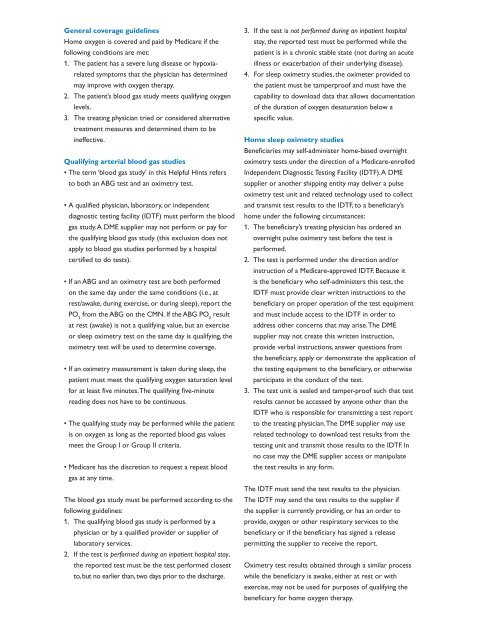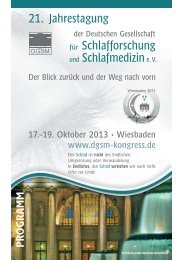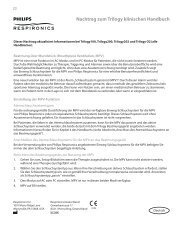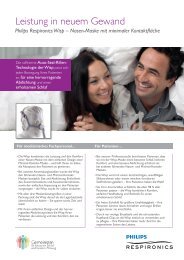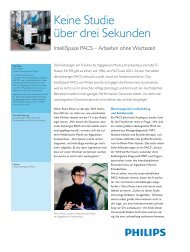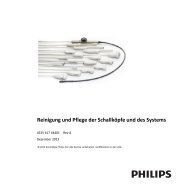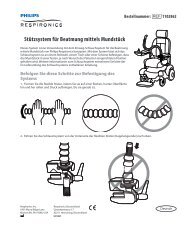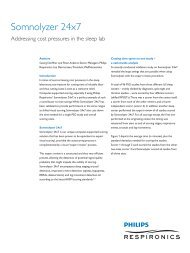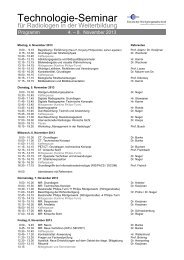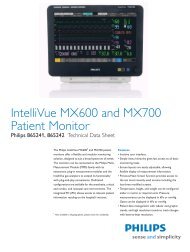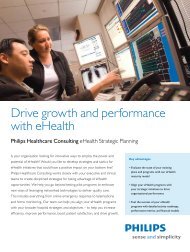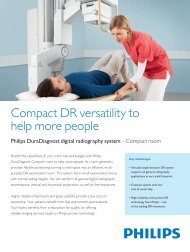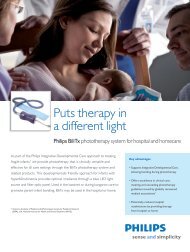Helpful hints for filing - Philips Healthcare
Helpful hints for filing - Philips Healthcare
Helpful hints for filing - Philips Healthcare
Create successful ePaper yourself
Turn your PDF publications into a flip-book with our unique Google optimized e-Paper software.
General coverage guidelines<br />
Home oxygen is covered and paid by Medicare if the<br />
following conditions are met:<br />
1. The patient has a severe lung disease or hypoxiarelated<br />
symptoms that the physician has determined<br />
may improve with oxygen therapy.<br />
2. The patient’s blood gas study meets qualifying oxygen<br />
levels.<br />
3. The treating physician tried or considered alternative<br />
treatment measures and determined them to be<br />
ineffective.<br />
Qualifying arterial blood gas studies<br />
• The term ‘blood gas study’ in this <strong>Helpful</strong> Hints refers<br />
to both an ABG test and an oximetry test.<br />
• A qualified physician, laboratory, or independent<br />
diagnostic testing facility (IDTF) must per<strong>for</strong>m the blood<br />
gas study. A DME supplier may not per<strong>for</strong>m or pay <strong>for</strong><br />
the qualifying blood gas study (this exclusion does not<br />
apply to blood gas studies per<strong>for</strong>med by a hospital<br />
certified to do tests).<br />
• If an ABG and an oximetry test are both per<strong>for</strong>med<br />
on the same day under the same conditions (i.e., at<br />
rest/awake, during exercise, or during sleep), report the<br />
PO 2<br />
from the ABG on the CMN. If the ABG PO 2<br />
result<br />
at rest (awake) is not a qualifying value, but an exercise<br />
or sleep oximetry test on the same day is qualifying, the<br />
oximetry test will be used to determine coverage.<br />
• If an oximetry measurement is taken during sleep, the<br />
patient must meet the qualifying oxygen saturation level<br />
<strong>for</strong> at least five minutes. The qualifying five-minute<br />
reading does not have to be continuous.<br />
• The qualifying study may be per<strong>for</strong>med while the patient<br />
is on oxygen as long as the reported blood gas values<br />
meet the Group I or Group II criteria.<br />
• Medicare has the discretion to request a repeat blood<br />
gas at any time.<br />
The blood gas study must be per<strong>for</strong>med according to the<br />
following guidelines:<br />
1. The qualifying blood gas study is per<strong>for</strong>med by a<br />
physician or by a qualified provider or supplier of<br />
laboratory services.<br />
2. If the test is per<strong>for</strong>med during an inpatient hospital stay,<br />
the reported test must be the test per<strong>for</strong>med closest<br />
to, but no earlier than, two days prior to the discharge.<br />
3. If the test is not per<strong>for</strong>med during an inpatient hospital<br />
stay, the reported test must be per<strong>for</strong>med while the<br />
patient is in a chronic stable state (not during an acute<br />
illness or exacerbation of their underlying disease).<br />
4. For sleep oximetry studies, the oximeter provided to<br />
the patient must be tamperproof and must have the<br />
capability to download data that allows documentation<br />
of the duration of oxygen desaturation below a<br />
specific value.<br />
Home sleep oximetry studies<br />
Beneficiaries may self-administer home-based overnight<br />
oximetry tests under the direction of a Medicare-enrolled<br />
Independent Diagnostic Testing Facility (IDTF). A DME<br />
supplier or another shipping entity may deliver a pulse<br />
oximetry test unit and related technology used to collect<br />
and transmit test results to the IDTF, to a beneficiary’s<br />
home under the following circumstances:<br />
1. The beneficiary’s treating physician has ordered an<br />
overnight pulse oximetry test be<strong>for</strong>e the test is<br />
per<strong>for</strong>med.<br />
2. The test is per<strong>for</strong>med under the direction and/or<br />
instruction of a Medicare-approved IDTF. Because it<br />
is the beneficiary who self-administers this test, the<br />
IDTF must provide clear written instructions to the<br />
beneficiary on proper operation of the test equipment<br />
and must include access to the IDTF in order to<br />
address other concerns that may arise. The DME<br />
supplier may not create this written instruction,<br />
provide verbal instructions, answer questions from<br />
the beneficiary, apply or demonstrate the application of<br />
the testing equipment to the beneficiary, or otherwise<br />
participate in the conduct of the test.<br />
3. The test unit is sealed and tamper-proof such that test<br />
results cannot be accessed by anyone other than the<br />
IDTF who is responsible <strong>for</strong> transmitting a test report<br />
to the treating physician. The DME supplier may use<br />
related technology to download test results from the<br />
testing unit and transmit those results to the IDTF. In<br />
no case may the DME supplier access or manipulate<br />
the test results in any <strong>for</strong>m.<br />
The IDTF must send the test results to the physician.<br />
The IDTF may send the test results to the supplier if<br />
the supplier is currently providing, or has an order to<br />
provide, oxygen or other respiratory services to the<br />
beneficiary or if the beneficiary has signed a release<br />
permitting the supplier to receive the report.<br />
Oximetry test results obtained through a similar process<br />
while the beneficiary is awake, either at rest or with<br />
exercise, may not be used <strong>for</strong> purposes of qualifying the<br />
beneficiary <strong>for</strong> home oxygen therapy.


